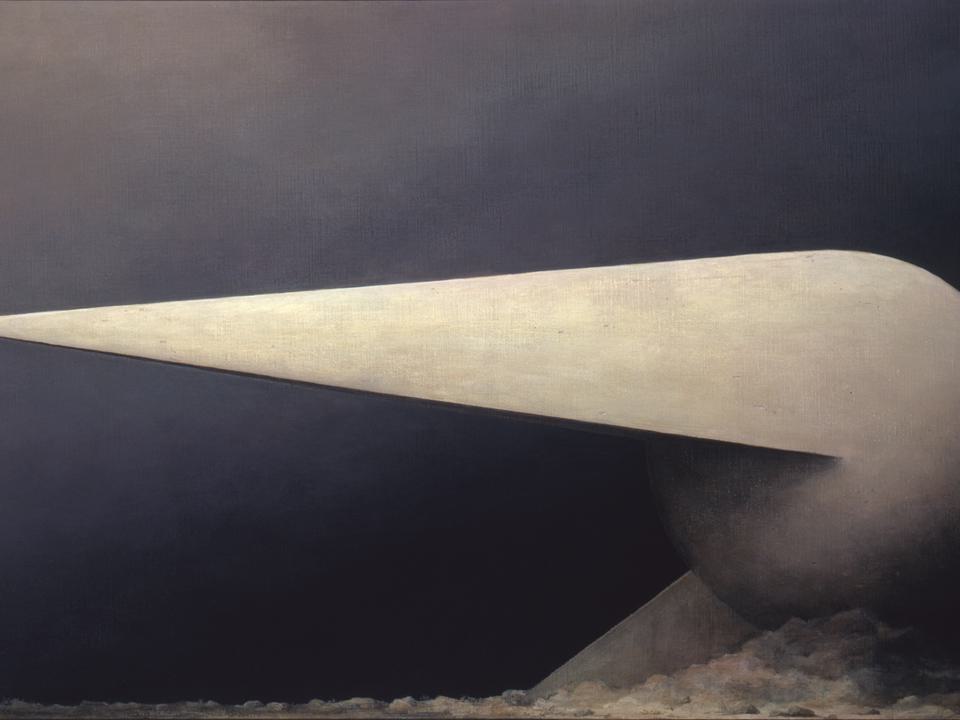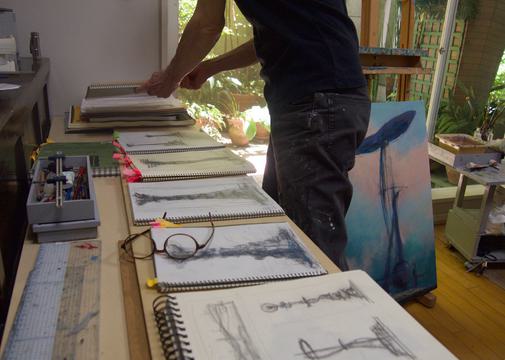
Introductions | Minoru Nomata
Introductions
Minoru Nomata
25 May – 2 July 2020
‘The exquisite draftsmanship and unique formal imagination of these paintings produces strong, ebullient architectural forms that transcend real time and space.’
Over the past four decades, Japanese artist Minoru Nomata has created a lexicon of imaginary buildings, monoliths, ‘eco-scapes’ and hybrid aerostats. In his singular, striking and heroic forms, Nomata celebrates the machine aesthetic and ingenuity of structural design throughout the ages. As Motoaki Hori, Chief Curator at the Tokyo Opera City Art Gallery describes it: ‘The exquisite draftsmanship and unique formal imagination of these paintings produces strong, ebullient architectural forms that transcend real time and space.’
Having grown up in the industrial Tokyo district of Meguro, at a time when Japan was undergoing rapid economic growth, Nomata became fascinated by urban design and its distinct architecture. At university, he studied European and Asian art, particularly classical Islamic patterns, and became drawn to the Machine Age and the modernism of American Precisionist, Charles Sheeler. It is these formative influences that have remained a constant in shaping Nomata’s imagery.
Working in series, Nomata consistently returns to the rationale of a single central motif; a superstructure anchored to land, sea or rising into the air. Although appearing as functional buildings, with entrances, apertures, stairways and cladding – elements that allow the viewer to orientate themselves by providing a sense of archetypal familiarity – the functionality of the structures remain elusive. Amalgamating past and present, they equally allude to the future.
'Introductions: Minoru Nomata’ is curated by Irene Bradbury, Director of Artist Liaison.

‘Painting is an escapist world, but I would like it to be a place to become energised [...] rather than a place to stay.’
Early Works
An external staircase leads up to the summit of the structure in Land-escape 8 (1992), where a trio of medieval flags flutter in the wind. Two buttresses supporting the front elevation provide a visual symmetry and flank two arches, one above the other, offering vistas into and through the building itself.
During the mid-90s, Nomata’s daughter fell dangerously ill and, unable to paint, Nomata found himself repeatedly drawing mountains or rock formations. Finding solace in nature, as he described it, ‘I clung to them’.

‘Nomata’s paintings have a strange presence like a living entity […] The paintings carry an atmosphere that seems to prove their existence. Quietly, or somewhat composedly, they seem to await our arrival.’
Windscapes
Set against darkened skies, the enigmatic ‘Windscapes’ appear aerodynamic yet are grounded like obelisks. In discussing these works, Nomata quotes from Paul Cézanne’s theoretical treatise: ‘Treat nature by means of the cylinder, the sphere, the cone, with everything put in perspective so that each side of an object or a plane is directed toward a central point.’

‘The reason why some of the circular structures appear in the ‘Points of View’ series is because I wanted to paint a nameless architecture.’
Points of View
Supported by a framework of wooden scaffolding and roped-off areas, the circular concrete cross-section of Points of View–8 (2004) typifies Nomata’s underlying interest in the incomplete and its potential.
Wooden scaffolding recurs in Points of View–19 (2004) as a tree appears in a state of restoration, enclosed and protected byarmy green canopies, drawing our attention to issues surrounding deforestation.
Minoru Nomata
Points of View-8, 2003


‘[in my paintings] construction, repair, and demolition are going on simultaneously.'
Minoru Nomata
Babel 2012, 2012
Titled after the biblical tower, Babel 2012 (2012) is Nomata’s dystopic imagining of a centralised government where the confluence of ‘construction, repair, and demolition are going on simultaneously’.
In essence, these structures are monuments representing the human condition: they symbolise our strengths and vulnerabilities. From growth and expansion through to mechanisation and power generated by greenhouses, wind-turbines and solar energy, they serve to highlight ongoing environmental issues.

‘Today, I am who I am,
We are who we are
And everything is, as it is
The pollen which we feed on’
Minoru Nomata
Seeds-12, 2004
Minoru Nomata
Seeds 12, 2004
Inspired by Pierre Barouh’s music, Nomata’s ‘Seeds’ drawings are the product of distilled memories and like his paintings, portray emblems of modernity.
Skyglow and Light Structures
Minoru Nomata
Skyglow-H11, 2008
Ascending descending–3 (2018) depicts a giant weather balloon just above the horizon, reminiscent of the red sun of Yusaku Kamekura’s 1964 Olympic poster. Tethered to the ground, this airborne spirit or orb floats in a suspended state, partly cast in shadow. The visionary architect, Terunobu Fujimori, sees Nomata as a ‘prophetic painter’ in whose imagery is a ‘foreshadowing of this future’.
Minoru Nomata
ascending descending-3, 2018
Elements Drawings
In April 2011, Nomata was invited by the newspaper The Asahi Shimbun, to contribute, on a weekly basis, a 15-centimetre square drawing, similar in scale to that of a CD cover. The request came a month after the seismic earthquake and ensuing Tsunami that took place on the north eastern coast of Japan. Unable to paint, Nomata turned his attention to this series of drawings, attempting to grasp the innate sorrow of ‘Japan after the disaster’. Nomata accumulated over two hundred of these drawings, collectively called the ‘Elements’ series.
‘The mission of these small pictures is to realize indistinct signs or indications that I can feel, in the forms of ‘structures’ or ‘situations’ [...] and I am always wishing that my architectural visions will eventually herald something positive.’
Create an Account
To view available artworks and access prices.



























